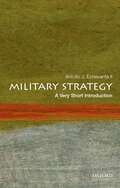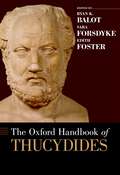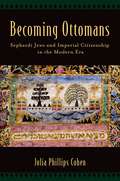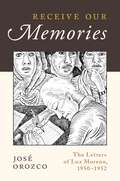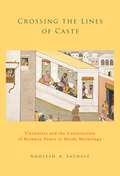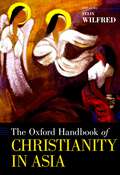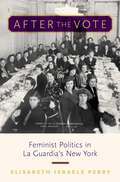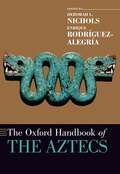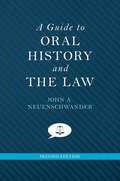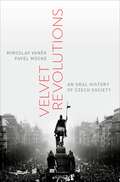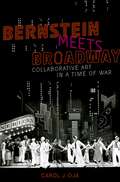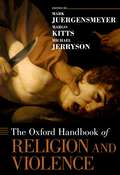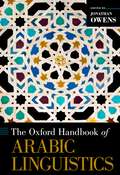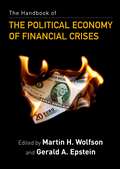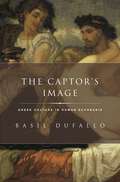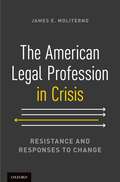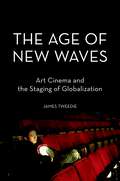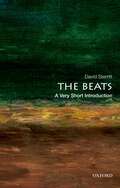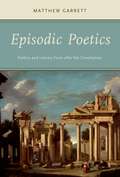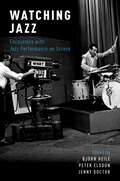- Table View
- List View
Military Strategy: An Alternative Paradigm For U. S. Military Strategy (Very Short Introductions)
by Antulio J. EchevarriaDistilling the ideas of the greatest military theoreticians of history, including Sun Tzu, Niccolò Machiavelli, and Carl von Clausewitz, Antulio J. Echevarria II presents a fascinating account of the "art of the general." Drawing on historical examples, from Hannibal's war against Rome to Napoleon's victory at Austerlitz, from the Allies' campaign to overwhelm Hitler's fortress to the terror attacks of September 11, Echevarria vividly describes the major types of military strategy and their advantages and disadvantages. Clear and engaging, this book shows that military strategy is essential for understanding major events of the past and becomes even more critical today, in a world increasingly threatened by weapons of mass destruction, terrorist attacks, and new dimensions of conflict such as cyberwar and space.
The Oxford Handbook of Thucydides (Oxford Handbooks)
The Oxford Handbook of Thucydides contains newly commissioned essays on Thucydides as an historian, thinker, and writer. It also features chapters on Thucydides' intellectual context and ancient reception. The creative juxtaposition of historical, literary, philosophical, and reception studies allows for a better grasp of Thucydides' complex project and its intellectual context, while at the same time providing a comprehensive introduction to the author's ideas. The volume is organized into four sections of papers: History, Historiography, Political Theory, and Context and Reception. It therefore bridges traditionally divided disciplines. The authors engaged to write the forty chapters for this volume include both well-known scholars and less well-known innovators, who bring fresh ideas and new points of view. Articles avoid technical jargon and long footnotes, and are written in an accessible style. Finally, the volume includes a thorough introduction prefacing each paper, as well as several maps and an up-to-date bibliography that will enable further study. The Oxford Handbook of Thucydides offers a comprehensive introduction to a thinker and writer whose simultaneous depth and innovativeness have been the focus of intense literary and philosophical study since ancient times.
Becoming Ottomans: Sephardi Jews and Imperial Citizenship in the Modern Era
by Julia Phillips CohenThe Ottoman-Jewish story has long been told as a romance between Jews and the empire. The prevailing view is that Ottoman Jews were protected and privileged by imperial policies and in return offered their unflagging devotion to the imperial government over many centuries. In this book, Julia Phillips Cohen offers a corrective, arguing that Jewish leaders who promoted this vision were doing so in response to a series of reforms enacted by the nineteenth-century Ottoman state: the new equality they gained came with a new set of expectations. Ottoman subjects were suddenly to become imperial citizens, to consider their neighbors as brothers and their empire as a homeland. Becoming Ottomans is the first book to tell the story of Jewish political integration into a modern Islamic empire. It begins with the process set in motion by the imperial state reforms known as the Tanzimat, which spanned the years 1839-1876 and legally emancipated the non-Muslims of the empire. Four decades later the situation was difficult to recognize. By the close of the nineteenth century, Ottoman Muslims and Jews alike regularly referred to Jews as a model community, or millet-as a group whose leaders and members knew how to serve their state and were deeply engaged in Ottoman politics. The struggles of different Jewish individuals and groups to define the public face of their communities is underscored in their responses to a series of important historical events. Charting the dramatic reversal of Jews in the empire over a half-century, Becoming Ottomans offers new perspectives for understanding Jewish encounters with modernity and citizenship in a centralizing, modernizing Islamic state in an imperial, multi-faith landscape.
Receive Our Memories: The Letters of Luz Moreno, 1950-1952
by José OrozcoReceive our Memories is a rare study of an epistolary relationship for individuals whose migration from Mexico has been looked at en masse, but not from such a personal and human angle. The heart of the book consists of eighty translated and edited versions of letters from Luz Moreno, a poor, uneducated Mexican sharecropper, to his daughter, a recent émigré to California, in the 1950s. These are contextualized and framed in light of immigration and labor history, the histories of Mexico and the United States in this period, and family history. Although Moreno's letters include many of the affective concerns and quotidian subject matter that are the heart and soul of most immigrant correspondence, they also reveal his deep attachment to a wider world that he has never seen. They include extensive discussions on the political events of his day (the Cold War, the Korean War, the atomic bomb, the conflict between Truman and MacArthur), ruminations on culture and religion (the role of Catholicism in the modern world, the dangers of Protestantism to Mexican immigrants to the United States), and extensive deliberations on the philosophical questions that would naturally preoccupy the mind of an elderly and sick man: Is life worth living? What is death? Will I be rewarded or punished in death? What does it mean to live a moral life? The thoughtfulness of Moreno's meditations and quantity of letters he penned, provide historians with the rare privilege of reading a part of the Mexican national narrative that, as Mexican author Elena Poniatowska notes, is usually "written daily, and daily erased."
RECEIVE OUR MEMORIES C: The Letters of Luz Moreno, 1950-1952
by José OrozcoReceive our Memories is a rare study of an epistolary relationship for individuals whose migration from Mexico has been looked at en masse, but not from such a personal and human angle. The heart of the book consists of eighty translated and edited versions of letters from Luz Moreno, a poor, uneducated Mexican sharecropper, to his daughter, a recent émigré to California, in the 1950s. These are contextualized and framed in light of immigration and labor history, the histories of Mexico and the United States in this period, and family history. Although Moreno's letters include many of the affective concerns and quotidian subject matter that are the heart and soul of most immigrant correspondence, they also reveal his deep attachment to a wider world that he has never seen. They include extensive discussions on the political events of his day (the Cold War, the Korean War, the atomic bomb, the conflict between Truman and MacArthur), ruminations on culture and religion (the role of Catholicism in the modern world, the dangers of Protestantism to Mexican immigrants to the United States), and extensive deliberations on the philosophical questions that would naturally preoccupy the mind of an elderly and sick man: Is life worth living? What is death? Will I be rewarded or punished in death? What does it mean to live a moral life? The thoughtfulness of Moreno's meditations and quantity of letters he penned, provide historians with the rare privilege of reading a part of the Mexican national narrative that, as Mexican author Elena Poniatowska notes, is usually "written daily, and daily erased."
Crossing the Lines of Caste: Visvamitra and the Construction of Brahmin Power in Hindu Mythology
by Adheesh A. SathayeWhat does it mean to be a Brahmin, and what could it mean to become one? Over the years, intellectuals and dogmatists have offered plenty of answers to the first question, but the latter presents a cultural puzzle, since normative Brahminical ideology deems it impossible for an ordinary individual to change caste without first undergoing death and rebirth. There is, however, one notable figure in the Hindu mythological tradition who is said to have transformed himself from a king into a Brahmin by amassing great ascetic power, or tapas: the ornery sage Visvamitra. Through texts composed in Sanskrit and vernacular languages, oral performances, and visual media, Crossing the Lines of Caste examines the rich mosaic of legends about Visvamitra found across the Hindu mythological tradition. It offers a comprehensive historical analysis of how the "storyworlds" conjured up through these various tellings have served to adapt, upgrade, and reinforce the social identity of real-world Brahmin communities, from the ancient Vedic past up to the hypermodern present. Using a performance-centered approach to situate the production of the Visvamitra legends within specific historical contexts, Crossing the Lines of Caste reveals how and why mythological culture has played an active, dialogical role in the construction of Brahmin social power over the last three thousand years.
The Oxford Handbook of Christianity in Asia (Oxford Handbooks)
Named by the International Bulletin of Missionary Studies as an Outstanding Book of 2014 for Mission Studies Despite the ongoing global expansion of Christianity, there remains a lack of comprehensive scholarship on its development in Asia. This volume fills the gap by exploring the world of Asian Christianity and its manifold expressions, including worship, theology, spirituality, inter-religious relations, interventions in society, and mission. The contributors, from over twenty countries, deconstruct many of the widespread misconceptions and interpretations of Christianity in Asia. They analyze how the growth of Christian beliefs throughout the continent is linked with the socio-political and cultural processes of colonization, decolonization, modernization, democratization, identity construction of social groups, and various social movements. With a particular focus on inter-religious encounters and emerging theological and spiritual paradigms, the volume provides alternative frames for understanding the phenomenon of conversion and studies how the scriptures of other religious traditions are used in the practice of Christianity within Asia.
American Arsenal: A Century of Waging War
by Patrick CoffeyWhen America declared war on Germany in 1917, the United States had only 200,000 men under arms, a twentieth of the German army's strength, and its planes were no match for the German air force. Less than a century later, the United States today has by far the world's largest military budget and provides over 40% of the world's armaments. In American Arsenal Patrick Coffey examines America's military transformation from an isolationist state to a world superpower. Focusing on fifteen specific developments, Coffey illustrates the unplanned, often haphazard nature of this transformation, which has been driven by political, military, technological, and commercial interests. Beginning with Thomas Edison's work on submarine technology, American Arsenal moves from World War I to the present conflicts in the Middle East, covering topics from chemical weapons, strategic bombing, and the nuclear standoff with the Soviet Union, to "smart" bombs, hand-held anti-aircraft missiles, and the Predator and other drone aircrafts. Coffey traces the story of each advance in weaponry from drawing board to battlefield, and includes fascinating portraits of the men who invented and deployed them -Edward Teller, "the father of the hydrogen bomb", Robert Oppenheimer, head of atomic bomb design at Los Alamos; Curtis LeMay, who led the fire-bombing of Japan; Herman Kahn, nuclear strategist and a model for Stanley Kubrick's Dr. Strangelove; Abraham Karem, inventor of the Predator, and many others. Coffey also examines the increasingly detached nature of modern American warfare- the ultimate goal is to remove soldiers from the battlefield entirely- which limits casualties (211,454 in Vietnam and only 1,231 in the Gulf War) but also lessens the political and psychological costs of going to war. Examining the backstories of every major American weapons development, American Arsenal is essential reading for anyone interested in the continuing evolution of the U.S. defense program.
After the Vote: Feminist Politics in La Guardia's New York
by Elisabeth Israels PerrySoon after his inauguration in 1934, New York City mayor Fiorello La Guardia began appointing women into his administration. By the end of his three terms in office, he had installed almost a hundred as lawyers in his legal department, but also as board and commission members and as secretaries, deputy commissioners, and judges. No previous mayor had done anything comparable. Aware they were breaking new ground for women in American politics, the "Women of the La Guardia Administration," as they called themselves, met frequently for mutual support and political strategizing. This is the first book to tell their stories. Author Elisabeth Israels Perry begins with the city's suffrage movement, which prepared these women for political action as enfranchised citizens. After they won the vote in 1917, suffragists joined political party clubs and began to run for office, many of them hoping to use political platforms to enact feminist and progressive public policies. Circumstances unique to mid-twentieth century New York City advanced their progress. In 1930, Governor Franklin D. Roosevelt authorized an inquiry into alleged corruption in the city's government, long dominated by the Tammany Hall political machine. The inquiry turned first to the Vice Squad's entrapment of women for sex crimes and the reported misconduct of the Women's Court. Outraged by the inquiry's disclosures and impressed by La Guardia's pledge to end Tammany's grip on city offices, many New York City women activists supported him for mayor. It was in partial recognition of this support that he went on to appoint an unprecedented number of them into official positions, furthering his plans for a modernized city government. In these new roles, La Guardia's women appointees not only contributed to the success of his administration but left a rich legacy of experience and political wisdom to oncoming generations of women in American politics.
After the Vote: Feminist Politics in La Guardia's New York
by Elisabeth Israels PerrySoon after his inauguration in 1934, New York City mayor Fiorello La Guardia began appointing women into his administration. By the end of his three terms in office, he had installed almost a hundred as lawyers in his legal department, but also as board and commission members and as secretaries, deputy commissioners, and judges. No previous mayor had done anything comparable. Aware they were breaking new ground for women in American politics, the "Women of the La Guardia Administration," as they called themselves, met frequently for mutual support and political strategizing. This is the first book to tell their stories. Author Elisabeth Israels Perry begins with the city's suffrage movement, which prepared these women for political action as enfranchised citizens. After they won the vote in 1917, suffragists joined political party clubs and began to run for office, many of them hoping to use political platforms to enact feminist and progressive public policies. Circumstances unique to mid-twentieth century New York City advanced their progress. In 1930, Governor Franklin D. Roosevelt authorized an inquiry into alleged corruption in the city's government, long dominated by the Tammany Hall political machine. The inquiry turned first to the Vice Squad's entrapment of women for sex crimes and the reported misconduct of the Women's Court. Outraged by the inquiry's disclosures and impressed by La Guardia's pledge to end Tammany's grip on city offices, many New York City women activists supported him for mayor. It was in partial recognition of this support that he went on to appoint an unprecedented number of them into official positions, furthering his plans for a modernized city government. In these new roles, La Guardia's women appointees not only contributed to the success of his administration but left a rich legacy of experience and political wisdom to oncoming generations of women in American politics.
The Oxford Handbook of the Aztecs (Oxford Handbooks)
The Oxford Handbook of the Aztecs, the first of its kind, provides a current overview of recent research on the Aztec empire, the best documented prehispanic society in the Americas. Chapters span from the establishment of Aztec city-states to the encounter with the Spanish empire and the Colonial period that shaped the modern world. Articles in the Handbook take up new research trends and methodologies and current debates. The Handbook articles are divided into seven parts. Part I, Archaeology of the Aztecs, introduces the Aztecs, as well as Aztec studies today, including the recent practice of archaeology, ethnohistory, museum studies, and conservation. The articles in Part II, Historical Change, provide a long-term view of the Aztecs starting with important predecessors, the development of Aztec city-states and imperialism, and ending with a discussion of the encounter of the Aztec and Spanish empires. Articles also discuss Aztec notions of history, writing, and time. Part III, Landscapes and Places, describes the Aztec world in terms of its geography, ecology, and demography at varying scales from households to cities. Part IV, Economic and Social Relations in the Aztec Empire, discusses the ethnic complexity of the Aztec world and social and economic relations that have been a major focus of archaeology. Articles in Part V, Aztec Provinces, Friends, and Foes, focuses on the Aztec's dynamic relations with distant provinces, and empires and groups that resisted conquest, and even allied with the Spanish to overthrow the Aztec king. This is followed by Part VI, Ritual, Belief, and Religion, which examines the different beliefs and rituals that formed Aztec religion and their worldview, as well as the material culture of religious practice. The final section of the volume, Aztecs after the Conquest, carries the Aztecs through the post-conquest period, an increasingly important area of archaeological work, and considers the place of the Aztecs in the modern world.
A Guide to Oral History and the Law (Oxford Oral History Series)
by John A. NeuenschwanderAccording to the Oral History Association, the term oral history refers to "a method of recording and preserving oral testimony" which results in a verbal document that is "made available in different forms to other users, researchers, and the public." Ordinarily such an academic process would seem to be far removed from legal challenges. Unfortunately this is not the case. While the field has not become a legal minefield, given its tremendous growth and increasing focus on contemporary topics, more legal troubles could well lie ahead if sound procedures are not put in place and periodically revisited. A Guide to Oral History and the Law is the definitive resource for all oral history practitioners. In clear, accessible language it thoroughly explains all of the major legal issues including legal release agreements, the protection of restricted interviews, the privacy torts (including defamation), copyright, the impact of the Internet, and the role of Institutional Review Boards (IRBs). The author accomplishes this by examining the most relevant court cases and citing examples of policies and procedures that oral history programs have used to avoid legal difficulties. Neuenschwander's central focus throughout the book is on prevention rather than litigation. He underscores this approach by strongly emphasizing how close adherence to the Oral History Association's Principles and Best Practices provides the best foundation for developing sound legal policies. The book also provides more than a dozen sample legal release agreements that are applicable to a wide variety of situations. This volume is an essential one for all oral historians regardless of their interviewing focus.
A Guide to Oral History and the Law (Oxford Oral History Series)
by John A. NeuenschwanderAccording to the Oral History Association, the term oral history refers to "a method of recording and preserving oral testimony" which results in a verbal document that is "made available in different forms to other users, researchers, and the public." Ordinarily such an academic process would seem to be far removed from legal challenges. Unfortunately this is not the case. While the field has not become a legal minefield, given its tremendous growth and increasing focus on contemporary topics, more legal troubles could well lie ahead if sound procedures are not put in place and periodically revisited. A Guide to Oral History and the Law is the definitive resource for all oral history practitioners. In clear, accessible language it thoroughly explains all of the major legal issues including legal release agreements, the protection of restricted interviews, the privacy torts (including defamation), copyright, the impact of the Internet, and the role of Institutional Review Boards (IRBs). The author accomplishes this by examining the most relevant court cases and citing examples of policies and procedures that oral history programs have used to avoid legal difficulties. Neuenschwander's central focus throughout the book is on prevention rather than litigation. He underscores this approach by strongly emphasizing how close adherence to the Oral History Association's Principles and Best Practices provides the best foundation for developing sound legal policies. The book also provides more than a dozen sample legal release agreements that are applicable to a wide variety of situations. This volume is an essential one for all oral historians regardless of their interviewing focus.
Velvet Revolutions: An Oral History of Czech Society (Oxford Oral History Series)
by Miroslav Vanek Pavel MückeThe Velvet Revolution in November 1989 brought about the collapse of the authoritarian communist regime in what was then Czechoslovakia, marking the beginning of the country's journey towards democracy. Though members of the elite have spoken about the transition to democracy, the experiences of ordinary people have largely gone untold. In Velvet Revolutions, Miroslav Vanek and Pavel Mücke examine the values of everyday citizens who lived under so-called real socialism, as well as how their values changed after the 1989 collapse. Based on 300 interviews, Vanek and Mücke give voice to everyone from farmers to managers, service workers to marketing personnel, manual laborers to members of the armed forces. Compelling and diverse, the oral histories touch upon the experience - and absence - of freedom, the value of family and friends, the experience of free time, and perceptions of foreign nations. Data from opinion polls conducted between 1970 and 2013 factor into the book's analysis, creating a well-rounded view of the ways in which popular thoughts, trends, and attitudes changed as Czech society transitioned from communism to democracy. From this rich foundation, Velvet Revolutions builds a multi-layered view of Czech history before 1989 and during the subsequent period of democratic transformation.
Velvet Revolutions: An Oral History of Czech Society (Oxford Oral History Series)
by Miroslav Vanek Pavel MückeThe Velvet Revolution in November 1989 brought about the collapse of the authoritarian communist regime in what was then Czechoslovakia, marking the beginning of the country's journey towards democracy. Though members of the elite have spoken about the transition to democracy, the experiences of ordinary people have largely gone untold. In Velvet Revolutions, Miroslav Vanek and Pavel Mücke examine the values of everyday citizens who lived under so-called real socialism, as well as how their values changed after the 1989 collapse. Based on 300 interviews, Vanek and Mücke give voice to everyone from farmers to managers, service workers to marketing personnel, manual laborers to members of the armed forces. Compelling and diverse, the oral histories touch upon the experience - and absence - of freedom, the value of family and friends, the experience of free time, and perceptions of foreign nations. Data from opinion polls conducted between 1970 and 2013 factor into the book's analysis, creating a well-rounded view of the ways in which popular thoughts, trends, and attitudes changed as Czech society transitioned from communism to democracy. From this rich foundation, Velvet Revolutions builds a multi-layered view of Czech history before 1989 and during the subsequent period of democratic transformation.
Bernstein Meets Broadway: Collaborative Art in a Time of War (Broadway Legacies)
by Carol J. OjaWinner of the 2015 Music in American Culture Award from the American Musicological Society When Leonard Bernstein first arrived in New York City, he was an unknown artist working with other brilliant twentysomethings, notably Jerome Robbins, Betty Comden, and Adolph Green. By the end of the 1940s, these artists were world famous. Their collaborations defied artistic boundaries and subtly pushed a progressive political agenda, altering the landscape of musical theater, ballet, and nightclub comedy. In Bernstein Meets Broadway: Collaborative Art in a Time of War, award-winning author and scholar Carol J. Oja examines the early days of Bernstein's career during World War II, centering around the debut in 1944 of the Broadway musical On the Town and the ballet Fancy Free. As a composer and conductor, Bernstein experienced a meteoric rise to fame, thanks in no small part to his visionary colleagues. Together, they focused on urban contemporary life and popular culture, featuring as heroes the itinerant sailors who bore the brunt of military service. They were provocative both artistically and politically. In a time of race riots and Japanese internment camps, Bernstein and his collaborators featured African American performers and a Japanese American ballerina, staging a model of racial integration. Rather than accepting traditional distinctions between high and low art, Bernstein's music was wide-open, inspired by everything from opera and jazz to cartoons. Oja shapes a wide-ranging cultural history that captures a tumultuous moment in time. Bernstein Meets Broadway is an indispensable work for fans of Broadway musicals, dance, and American performance history.
The Oxford Handbook of Religion and Violence (Oxford Handbooks)
by Mark Juergensmeyer Margo Kitts Michael JerrysonViolence has always played a part in the religious imagination, from symbols and myths to legendary battles, from colossal wars to the theater of terrorism. The Oxford Handbook of Religion and Violence surveys intersections between religion and violence throughout history and around the world. The forty original essays in this volume include overviews of major religious traditions, showing how violence is justified within the literary and theological foundations of the tradition, how it is used symbolically and in ritual practice, and how social acts of violence and warfare have been justified by religious ideas. The essays also examine patterns and themes relating to religious violence, such as sacrifice and martyrdom, which are explored in cross-disciplinary or regional analyses; and offer major analytic approaches, from literary to social scientific studies. The contributors to this volume--innovative thinkers who are forging new directions in theory and analysis related to religion and violence--provide novel insights into this important field of studies. By mapping out the whole field of religion and violence, The Oxford Handbook of Religion and Violence will prove an authoritative source for students and scholars for years to come.
The Oxford Handbook of Arabic Linguistics (Oxford Handbooks)
by Jonathan OwensArabic is one of the world's largest languages, spoken natively by nearly 300 million people. By strength of numbers alone Arabic is one of our most important languages, studied by scholars across many different academic fields and cultural settings. It is, however, a complex language rooted in its own tradition of scholarship, constituted of varieties each imbued with unique cultural values and characteristic linguistic properties. Understanding its linguistics holistically is therefore a challenge. The Oxford Handbook of Arabic Linguistics is a comprehensive, one-volume guide that deals with all major research domains which have been developed within Arabic linguistics. Chapters are written by leading experts in the field, who both present state-of-the-art overviews and develop their own critical perspectives. The Handbook begins with Arabic in its Semitic setting and ends with the modern dialects; it ranges across the traditional--the classical Arabic grammatical and lexicographical traditions--to the contemporary--Arabic sociolinguistics, Creole varieties and codeswitching, psycholinguistics, and Arabic as a second language - while situating Arabic within current phonetic, phonological, morphological, syntactic and lexicological theory. An essential reference work for anyone working within Arabic linguistics, the book brings together different approaches and scholarly traditions, and provides analysis of current trends and directions for future research.
The Handbook of the Political Economy of Financial Crises
The Great Financial Crisis that began in 2007 reminds us with devastating force that financial instability and crises are endemic to capitalist economies, and that it is only strong and dynamically-changing financial regulations that can keep the damage caused by these crises within bounds. The international financial system and individual national economies, including that of the United States, are suffering from the aftermath of the worst financial crisis since the Great Depression. Economists are struggling to understand the origins and implications of the crisis. The Handbook of the Political Economy of Financial Crises uses a political economy theoretical framework to analyze the crisis. After an opening chapter that describes the dimensions of the current crisis, the next section provides relevant theoretical frameworks. Subsequent sections apply these theoretical frameworks to analyze the background, dimensions, and implications of the crisis for the world economy. Leading scholars push forward our understanding of how and why our international and domestic economies are susceptible to financial breakdown and what can be done to mitigate this problem in the future. The methodology throughout applies theoretical concepts in the context of an historical and institutional understanding of the real world. By emphasizing the historical and institutional aspects of financial crises, the authors advance economic knowledge and provide insights into how we can manage our financial system to improve the lives of ordinary people.
The Captor's Image: Greek Culture in Roman Ecphrasis (Classical Culture and Society)
by Basil DufalloAn influential view of ecphrasis--the literary description of art objects--chiefly treats it as a way for authors to write about their own texts without appearing to do so, and even insist upon the aesthetic dominance of the literary text over the visual image. However, when considering its use in ancient Roman literature, this interpretation proves insufficient. The Captor's Image argues for the need to see Roman ecphrasis, with its prevalent focus on Hellenic images, as a site of subtle, ongoing competition between Greek and Roman cultures. Through close readings of ecphrases in a wide range of Latin authors--from Plautus, Catullus, and Horace to Vergil, Ovid, and Martial, among others--Dufallo contends that Roman ecphrasis reveals an ambivalent receptivity to Greek culture, an attitude with implications for the shifting notions of Roman identity in the Republican and Imperial periods. Individual chapters explore how the simple assumption of a self-asserting ecphrastic text is called into question by comic performance, intentionally inconsistent narrative, satire, Greek religious iconography, the contradictory associations of epic imagery, and the author's subjection to a patron. Visual material such as wall painting, statuary, and drinkware vividly contextualizes the discussion. As the first book-length treatment of artistic ecphrasis at Rome, The Captor's Image resituates a major literary trope within its hybrid cultural context while advancing the idea of ecphrasis as a cultural practice through which the Romans sought to redefine their identity with, and against, Greekness.
The American Legal Profession in Crisis: Resistance and Responses to Change
by James E. MoliternoThroughout history, the American legal profession has tried to hold tight to its identity by retreating into its traditional values and structure during times of self-perceived crisis. The American Legal Profession in Crisis: Resistance and Responses to Change analyzes the efforts of the legal profession to protect and maintain the status quo even as the world around it changed. Author James E. Moliterno, consistently argues that the profession has resisted societal change and sought to ban or discourage new models of legal representation created by such change. In response to every crisis, lawyers asked: "How can we stay even more 'the same' than we already are?" The legal profession has been an unwilling, capitulating entity to any transformation wrought by the overwhelming tide of change. Only when the shifts in society, culture, technology, economics, and globalization could no longer be denied did the legal profession make any proactive changes that would preserve status quo. This book demonstrates how the profession has held to its anachronistic ways at key crisis points in US history: Watergate, communist infiltration, waves of immigration, the explosion of litigation, and the current economic crisis that blends with dramatic changes in technology, communications, and globalization. Ultimately, Moliterno urges the profession to look outward and forward to find in society and culture the causes and connections with these periodic crises. Doing so would allow the profession to grow with the society, solve problems with, rather than against, the flow of society, and be more attuned to the very society the profession claims to serve. This paperback version includes a commentary on the prevailing crisis in legal education.
The Age of New Waves: Art Cinema and the Staging of Globalization
by James TweedieThe Age of New Waves examines the origins of the concept of the "new wave" in 1950s France and the proliferation of new waves in world cinema over the past three decades. The book suggests that youth, cities, and the construction of a global market have been the catalysts for the cinematic new waves of the past half century. It begins by describing the enthusiastic engagement between French nouvelle vague filmmakers and a globalizing American cinema and culture during the modernization of France after World War II. It then charts the growing and ultimately explosive disenchantment with the aftermath of that massive social, economic, and spatial transformation in the late 1960s. Subsequent chapters focus on films and visual culture from Taiwan and contemporary mainland China during the 1980s and 1990s, and they link the recent propagation of new waves on the international film festival circuit to the "economic miracles" and consumer revolutions accompanying the process of globalization. While it travels from France to East Asia, the book follows the transnational movement of a particular model of cinema organized around mise en scène--or the interaction of bodies, objects, and spaces within the frame--rather than montage or narrative. The "master shot" style of directors like Hou Hsiao-Hsien, Tsai Ming-Liang, and Jia Zhangke has reinvented a crucial but overlooked tendency in new wave film, and this cinema of mise en scène has become a key aesthetic strategy for representing the changing relationships between people and the material world during the rise of a global market. The final chapter considers the interaction between two of the most global phenomena in recent film history--the transnational art cinema and Hollywood--and it searches for traces of an American New Wave.
The Beats: A Very Short Introduction (Very Short Introductions)
by David SterrittIn the late 1950s and early 1960s, the writers of the Beat Generation revolutionized American literature with their iconoclastic approach to language and their angry assault on the conformity and conservatism of postwar society. They and their followers took aim at the hypocrisy and taboos of their time--particularly those involving sex, race, and class--in such provocative works as Jack Kerouac's On the Road (1957), Allen Ginsberg's "Howl" (1956), and William S. Burroughs's Naked Lunch (1959). In this Very Short Introduction, David Sterritt offers a concise overview of the social, cultural, and aesthetic sensibilities of the Beats, bringing out the similarities that connected them and also the many differences that made them a loosely knit collective rather than an organized movement. Figures in the saga include Neal Cassady, Gregory Corso, Lawrence Ferlinghetti, John Clellon Holmes, Carolyn Cassady, and Gary Snyder. As Sterritt ranges from Greenwich Village and San Francisco to Mexico, western Europe, and North Africa, he sheds much light on how the Beats approached literature, drugs, sexuality, art, music, and religion. Members of the Beat Generation hoped that their radical rejection of materialism, consumerism, and regimentation would inspire others to purify their lives and souls as well. Yet they urged the remaking of consciousness on a profoundly inward-looking basis, cultivating "the unspeakable visions of the individual," in Kerouac's phrase. The idea was to revolutionize society by revolutionizing thought, not the other way around. This book explains how the Beats used their antiauthoritarian visions and radical styles to challenge dominant values, fending off absorption into mainstream culture while preparing ground for the larger, more explosive social upheavals of the 1960s. More than half a century later, the Beats' impact can still be felt in literature, cinema, music, theater, and the visual arts. This compact introduction explains why. About the Series: Oxford's Very Short Introductions series offers concise and original introductions to a wide range of subjects--from Islam to Sociology, Politics to Classics, Literary Theory to History, and Archaeology to the Bible. Not simply a textbook of definitions, each volume in this series provides trenchant and provocative--yet always balanced and complete--discussions of the central issues in a given discipline or field. Every Very Short Introduction gives a readable evolution of the subject in question, demonstrating how the subject has developed and how it has influenced society. Eventually, the series will encompass every major academic discipline, offering all students an accessible and abundant reference library. Whatever the area of study that one deems important or appealing, whatever the topic that fascinates the general reader, the Very Short Introductions series has a handy and affordable guide that will likely prove indispensable.
Episodic Poetics: Politics and Literary Form after the Constitution
by Matthew GarrettThe early United States was a culture of the episode. In Episodic Poetics, Matthew Garrett merges narrative theory with social and political history to explain the early American fascination with the episodic, piecemeal plot. Since Aristotle's Poetics, the episode has been a vexed category of literary analysis, troubling any easy view of the subsumption of unwieldy narrative parts into well-plotted wholes. Garrett puts forward a new, dialectical theory of episodic form to recast this peculiar object of literary history, looking to the episode as a narrative unit smaller than the genre in order to give an account of all the period's major prose genres. Garrett shows how, in ways both magisterial and mundane, episodic forms gave variegated shape to the social, political, and economic conflicts that defined the moment of national formation. Episodic Poetics proposes a new method of reading and a new way of conceiving of literary history. The book asks how we might understand the cultural role of the episode as a literary micro-unit, one that forces us to read individual narratives in terms of an always partial and fraught development toward plot. Episodic Poetics combines theoretical reflection and historical rigor with careful readings of texts from the early American canon such as The Federalist, Benjamin Franklin's Autobiography, and the novels of Charles Brockden Brown, along with hitherto understudied texts and ephemera such as Washington Irving's Salmagundi, Susanna Rowson's Trials of the Human Heart and the memoirs of the metalworker and failed entrepreneur John Fitch. Garrett recounts literary history not as the easy victory of grand nationalist ambitions, but rather as a series of social struggles expressed through writers' recurring engagement with incompletely integrated forms.
Watching Jazz: Encounters with Jazz Performance on Screen
by Bjö Heile Peter Elsdon Jenny DoctorWatching Jazz: Encounters with Jazz Performance on Screen is the first systematic study of jazz on screen media. Where earlier studies have focused almost entirely on the role and portrayal of jazz in Hollywood film, the present book engages with a plethora of technologies and media from early film and soundies through television to recent developments in digital technologies and online media. Likewise, the authors discuss jazz in the widest sense, ranging from Duke Ellington and Jimmy Dorsey through the likes of Dizzy Gillespie, Art Blakey, Oscar Peterson, Miles Davis, John Coltrane and Charles Mingus to Pat Metheny. Much of this rich and fascinating material has never been studied in depth before, and what emerges most clearly are the manifold connections between the music and the media on which it was and is being recorded. Its long association with film and television has left its trace in jazz, just as online and social media are subtly shaping it now. Vice versa, visual media have always benefited from focusing on music and this significantly affected their development. The book follows these interrelations, showing how jazz was presented and represented on screen and what this tells us about the music, the people who made it and their audiences. The result is a new approach to jazz and the media, which will be required reading for students of both fields.
